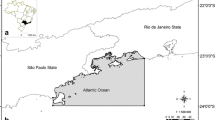Abstract
Harvested by coastal populations for centuries, seaweeds have played an important role in the economy of a number of countries. In Brazil, they occur along the coastline, but are more diversified and abundant from the northeast to a portion of the southeast coast. Historically, the seaweed industry in Brazil is based on seaweed harvesting of natural beds. This practice continues to this day in a number of coastal communities in Northeastern Brazil. Since the 1960s, species of the genera Gracilaria and Hypnea have been collected in the intertidal zone for extraction of agar and carrageenan. Maximum production was achieved in 1973–1974, a period in which the country exported around 2000 t annually (dry weight) to Japan. Later (1977–1979), there was a sharp drop and annual exports fell to 250 t (dry weight). In 1981, Brazil exported only 150 t of dried seaweed for agar extraction. Between 1990 and 2000, overexploitation, decline in a number of agarophyte populations, poor quality, low price, and lack of a socioeconomic policy led to the almost total disappearance of this industry in Northeastern Brazil. Seaweed harvesting on natural beds is currently in decline, and the population that depended on this resource had to migrate or convert to other economic activities, such as fishing, aquaculture, and underwater tourism. However, the promising results obtained in pilot projects (Gracilaria and Kappaphycus) show that Brazil has significant potential as a seaweed biomass producer.




Similar content being viewed by others
References
Bezerra AF, Marinho-Soriano E (2010) Cultivation of the red seaweed Gracilaria birdiae (Gracilariales, Rhodophyta) in tropical waters of northeast Brazil. Biomass Bioenergy 34:1813–1817
Brennan, W (2013) Cultivating Change: Women’s Involvement in a Brazilian Seaweed Collective . Honors projects. Paper 19. Available in: http://digitalcommons.macalester.edu/anth_honors/19 (Accessed: April 15 2016)
Craigie JS (2011) Seaweed extract stimuli in plant science and agriculture. J Appl Phycol 23:371–393
Durairatnam M (1980) Studies on the agar producing seaweeds and their distribution in Northeast Brazil. Ciência e Cultura 32:1358–1372
Durairatnam M, Medeiros TMB, Sena AM (1990) Studies on the yield and gel strength of Agar from Gracilaria domingensis Sonder ex Kuetzing (Gracilariales, Rhodophyta) following the addition of calcium. Hydrobiologia 204/205:551–553
FAO (1991) Yearbook of fishery statistics: catches and landings, 1989, vol 68. Food and Agricultural Organisation of the United Nations, Rome
Ferreira MT, Câmara-Neto OEC, Morais SB, Vasconcelos MDT (1981) Prospecção dos bancos de algas marinhas do Estado do Rio Grande do Norte, 1ª Parte—Profundidade 0-10m. SUDENE 2:27–81
Freddi A, Aguilar-Manjarrez J (2003) Small-scale seaweed farming in North East Brazil. TCP/BRA/0065 35 FAO Aquaculture Newsletter 32
Hayashi L, Santos AA, Faria GSM, Nunes BG, Souza MS et al (2011) Kappaphycus alvarezii (Rhodophyta, Areschougiaceae) cultivated in subtropical waters in Southern Brazil. J Appl Phycol 23:337–343
Marinho-Soriano E (1999) Species composition of seaweeds in Buzios Beach, Rio Grande do Norte, Brazil. Seaweed Res Utiln 21:9–13
Marinho-Soriano E (2007) Seaweeds biofilters: an environmentally friendly solution. World Aquacult 38:31–33
Marinho-Soriano E, Silva TSF, Moreira WSC (2001) Seasonal variation in the biomass and agar yield from Gracilaria cervicornis and Hydropuntia cornea from Brasil. Bioresour Technol 77:115–120
Marinho-Soriano E, Morales C, Moreira WSC (2002) Cultivation of Gracilaria (Rhodophyta) in shrimp pond effluents in Brazil. Aquacult Res 33:1081–1086
Marinho-Soriano E, Moreira WSC, Carneiro MAA (2006) Some aspects of the growth of Gracilaria birdiae (Gracilariales, Rhodophyta) in an estuary in northeast Brazil. Aquacult Int 14:327–336
Marinho-Soriano E, Panucci RA, Carneiro MAA, Pereira DC (2009) Evaluation of Gracilaria caudata J. Agardh for bioremediation of nutrients from shrimp farming wastewater. Bioresour Technol 100:6192–6198
McHugh DJ (2003) A guide to the seaweed industry. FAO Fisheries Technical paper, No 441: 105 p.
MDIC – Ministério do Desenvolvimento, Indústria e Comércio Exterior. Dados de Exportação. Available in: http//aliceweb.mdic.gov.br/(Accessed: Nov 20 2015)
MMA – Ministério do Meio Ambiente (2008) Áreas prioritárias para conservação, uso sustentável e repartição de benefícios da biodiversidade brasileira. 328 pp.
Oliveira EC (1998) The seaweed resources of Brazil. In: Critchley AT, Ohno M (eds) Seaweed resources of the world. Japan International Cooperation Agency, Yokosuka, pp 367–371
Oliveira EC, Horta PA, Amancio CE, Santanna CL (2002) Algas e angiospermas marinhas bênticas do litoral brasileiro: diversidade, explotação e conservação. In Avaliação e ações prioritárias para a conservação da biodiversidade das zonas costeira e marinha. (Ministério do Meio Ambiente, ed.). Brasília CDRom
Oliveira VP, Freire FAM, Marinho-Soriano E (2012) Influence of depth on the growth of the seaweed Gracilaria birdiae (Rhodophyta) in a shrimp pond. Braz J Aquat Sci Technol 16:33–39
Paula EJ, Pereira RTL, Ohno M (2002) Growth rate of the carrageenophyte Kappaphycus alvarezii (Rhodophyta, Gigartinales) introduced in subtropical waters of São Paulo State, Brazil. Phycol Res 50:1–9
Pellizzari F, Reis RP (2011) Seaweed cultivation on the southern and southeastern Brazilian coast. Braz J Pharmacog 21:305–312
Prates APL (2007) National Plan for Protected AreasMarine and CoastalAreas Context. In: MMA/SBF. 2007. Aquatic Protected Areas as Fisheries Management tools. 18–24 p
Rebours C, Marinho-Soriano E, Zertuche-González JA, Hayashi L, Vásquez JA, Kradolfer P, Soriano G, Ugarte R, Abreu MH, Bay-Larsen I, Rødven R, Robledo D (2014) Seaweeds: an opportunity for wealth and sustainable livelihood for coastal communities. J Appl Phycol 26:1939–1951
Reis RP, Bastos M, Góes HG (2007) Cultivo de Kappaphycus alvarezii no litoral do Rio de Janeiro. Panorama Aqüicultura 17(89):42–47
SUDENE (1981) Projeto Algas—Estado do Rio Grande do Norte. Estudos de Pesca 9:1–120
UNCTAD/GATT (1981) Estudio Piloto sobre la Industria y el Comercio Mundiales de Algas. Center for International Commerce, Geneva, 99 pp
Acknowledgments
This study was supported by Conselho Nacional de Desenvolvimento Científico e Tecnológico (CNPq). I would like to thank the editor and two anonymous reviewers for their suggestions and comments.
Author information
Authors and Affiliations
Corresponding author
Rights and permissions
About this article
Cite this article
Marinho-Soriano, E. Historical context of commercial exploitation of seaweeds in Brazil. J Appl Phycol 29, 665–671 (2017). https://doi.org/10.1007/s10811-016-0866-8
Received:
Revised:
Accepted:
Published:
Issue Date:
DOI: https://doi.org/10.1007/s10811-016-0866-8




